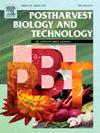Phenylpropanoid pathway mediated the defense response of ‘Korla’ fragrant pear against Alternaria alternata infection
IF 6.4
1区 农林科学
Q1 AGRONOMY
引用次数: 0
Abstract
Alternaria alternata has been found to be the dominating pathogenic fungus of harvested ‘Korla’ fragrant pear, and the resulting blackhead disease is a significant factor affecting the storage quality of pears. The present study explored the specific mechanisms by which the phenylpropanoid pathway mediates the defense response to A. alternata infection in pear fruit. In the A. alternata-inoculated group, the fruit exhibited increased activity and gene expression levels of key enzymes (PAL, C4H, and 4CL) as well as higher content of phenolic acids (trans-cinnamic acid, ferulic acid, caffeic acid, p-coumaric acid, and sinapic acid) and total phenol in the general phenylpropanoid pathway. In the mid-to-late storage period, the activity and gene expression levels of key enzymes in the lignin biosynthetic pathway (CCR and CAD) were suppressed, and the content of lignin monomers (sinapyl alcohol, coniferyl alcohol, and p-coumaryl alcohol) and lignin was reduced. Notably, the activity and gene expression levels of flavonoid biosynthetic pathway-related enzymes (CHS and CHI) as well as the content of various flavonoids (naringenin, apigenin, rutin, quercetin, and epicatechin) and total flavonoids continuously increased in response to A. alternata infection in the early to middle stages of storage but declined in the late storage period. In summary, the initial infection of A. alternata infection activated the stress response of pear fruit, particularly the phenylpropanoid–flavonoid branch pathway, to enhance the fruit’s defense against pathogens, but with the prolongation of the infestation time, the fruit could not continuously resist the invasion of pathogens, ultimately leading to the outbreak of disease. The present findings furnish a theoretical foundation further elucidating the interaction between ‘Korla’ fragrant pear and A. alternata and for developing an effective strategy to control the blackhead disease.
苯丙酮途径介导了 "Korla "香梨对交替孢霉感染的防御反应
研究发现,交替丝核菌是采收的 "Korla "香梨的主要致病真菌,由此导致的黑头病是影响梨贮藏质量的一个重要因素。本研究探讨了苯丙氨酸途径介导梨果对交替花叶病毒感染的防御反应的具体机制。在交替穗霉感染组,果实中关键酶(PAL、C4H 和 4CL)的活性和基因表达水平都有所提高,酚酸(反式肉桂酸、阿魏酸、咖啡酸、对香豆酸和山奈酸)和总酚在一般苯丙氨酸途径中的含量也有所提高。在贮藏中后期,木质素生物合成途径中关键酶(CCR 和 CAD)的活性和基因表达水平受到抑制,木质素单体(山奈醇、针叶醇和对香豆醇)和木质素的含量降低。值得注意的是,黄酮类生物合成途径相关酶(CHS和CHI)的活性和基因表达水平以及各种黄酮类化合物(柚皮苷、芹菜素、芦丁、槲皮素和表儿茶素)和总黄酮类化合物的含量在贮藏早期和中期受交替穗霉感染后持续上升,但在贮藏后期有所下降。综上所述,交替孢霉感染初期激活了梨果的应激反应,尤其是苯丙酮-类黄酮分支途径,增强了果实对病原菌的防御能力,但随着侵染时间的延长,果实无法持续抵御病原菌的入侵,最终导致病害的爆发。本研究结果为进一步阐明'Korla'香梨与交替花叶病毒之间的相互作用以及制定有效的黑头病控制策略奠定了理论基础。
本文章由计算机程序翻译,如有差异,请以英文原文为准。
求助全文
约1分钟内获得全文
求助全文
来源期刊

Postharvest Biology and Technology
农林科学-农艺学
CiteScore
12.00
自引率
11.40%
发文量
309
审稿时长
38 days
期刊介绍:
The journal is devoted exclusively to the publication of original papers, review articles and frontiers articles on biological and technological postharvest research. This includes the areas of postharvest storage, treatments and underpinning mechanisms, quality evaluation, packaging, handling and distribution of fresh horticultural crops including fruit, vegetables, flowers and nuts, but excluding grains, seeds and forages.
Papers reporting novel insights from fundamental and interdisciplinary research will be particularly encouraged. These disciplines include systems biology, bioinformatics, entomology, plant physiology, plant pathology, (bio)chemistry, engineering, modelling, and technologies for nondestructive testing.
Manuscripts on fresh food crops that will be further processed after postharvest storage, or on food processes beyond refrigeration, packaging and minimal processing will not be considered.
 求助内容:
求助内容: 应助结果提醒方式:
应助结果提醒方式:


